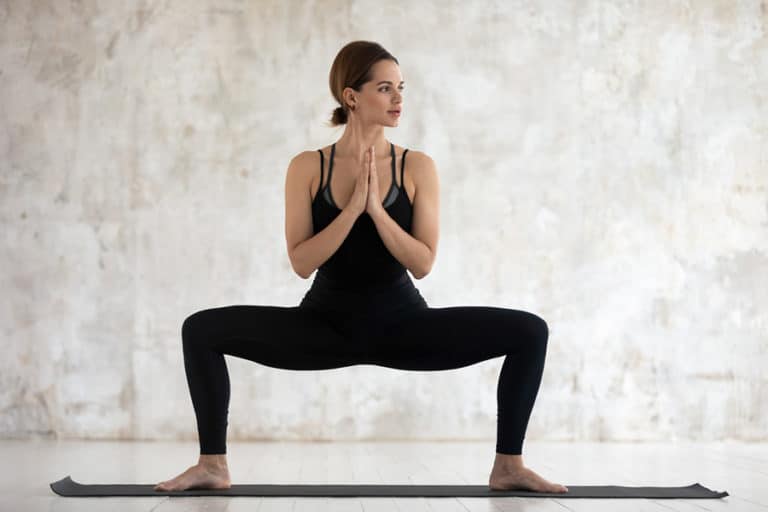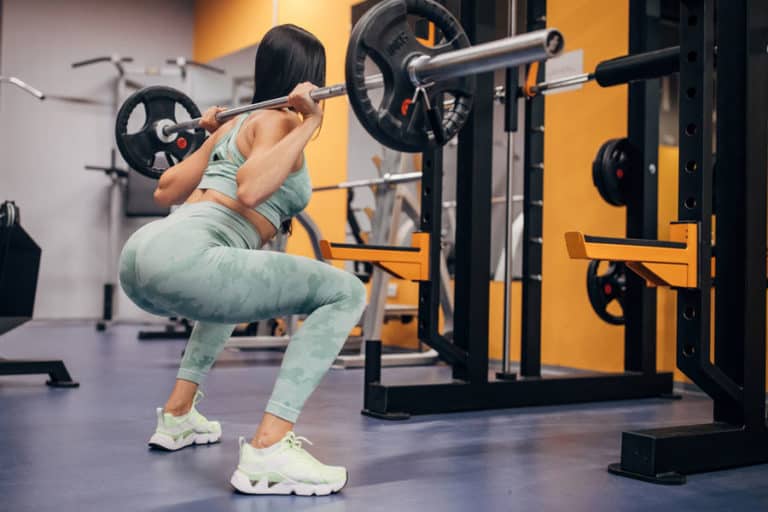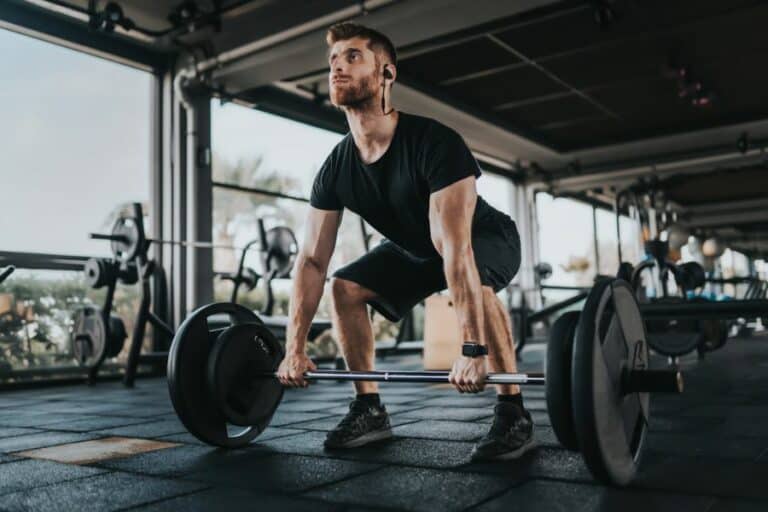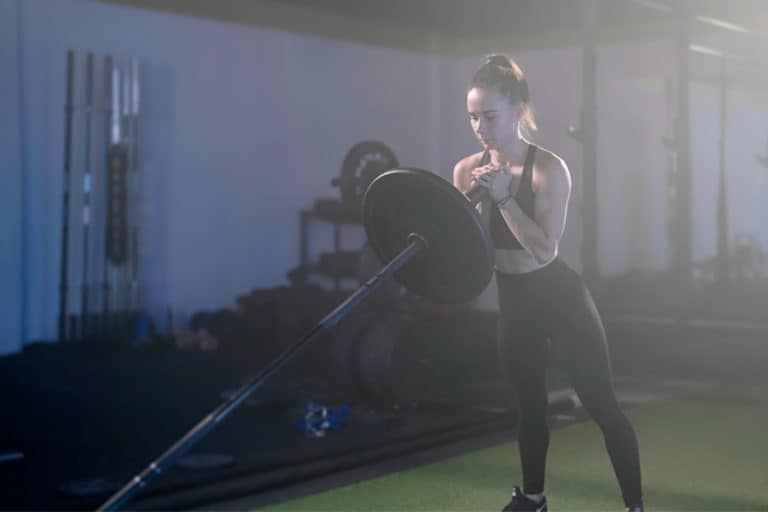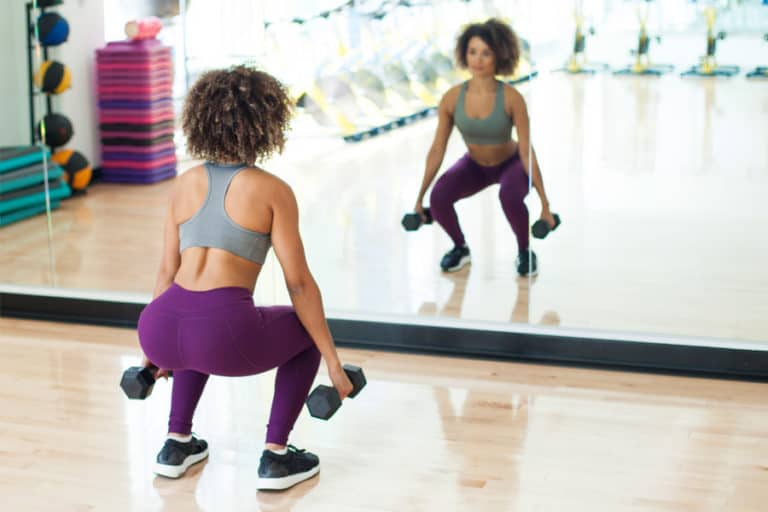Leg Press Vs Squat: Similarities, Differences And More
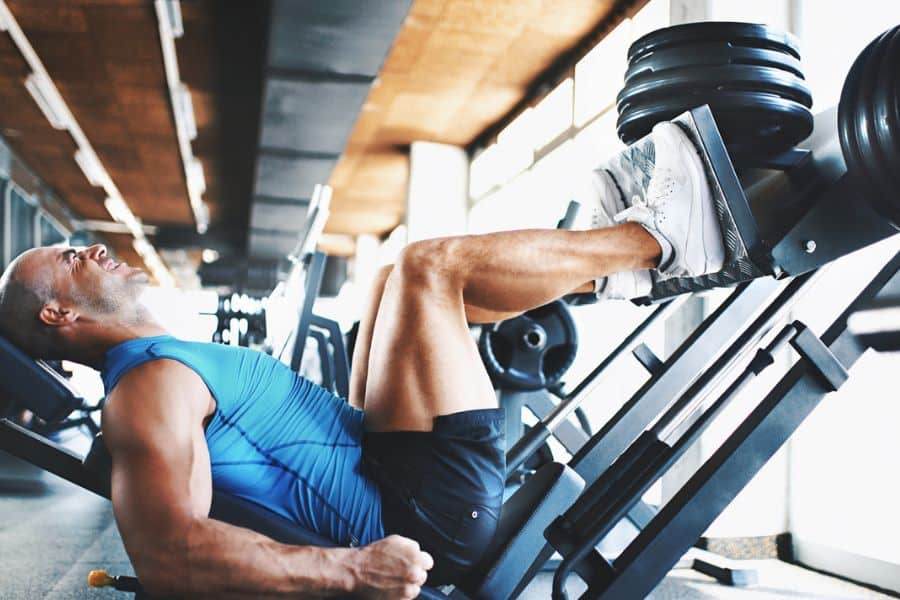
Leg Press Vs. Squat | Muscles Worked | Other Differences | Similarities | Which Is Better? | Squat And Leg Press On The Same Day? | Benefits/Risks Of Leg Press | Benefits/Risks Of Squat | Tips For Safety
Leg press vs squat: The difference
The leg press is an exercise that involves pressing a weighted sled away from the body while seated on a machine. The machine typically has a backrest and footplate, and the weight is usually loaded onto the sled.
In contrast, squats are performed by standing with a barbell across the shoulders and then squatting down until the thighs are parallel to the ground(in most cases).
Muscles worked by leg presses and squats
Squat: Muscles worked
Squats are compound exercises that engage and work multiple muscle groups [1]National Academy of Sports Medicine: THE MUSCLES USED IN SQUATS – SQUAT BIOMECHANICS EXPLAINED. The primary muscles worked by squats are:
- Quadriceps: Squats primarily target the quadriceps. Quads are the large muscles on the front of the thigh. These muscles are responsible for extending the knee joint and straightening the leg.
- Hamstrings: Squats, particularly deep squats, stretch and work the hamstrings. The hamstrings are the muscles on the back of the thigh. These muscles are responsible for flexing the knee and bending the leg.
- Glutes: Squats are the go-to exercise for building the glutes. The gluteal muscles, put together, form the largest muscle in the body. The functions of glute muscles [2]National Institute for Fitness & Sport: Ultimate Glute Blog (Part 1of 2): Glute Anatomy and Function include the movements of the hip joint and the abduction and rotation of the thigh muscles.
- Core muscles: Squats engage the core muscles, including the abdominals, obliques, and erector spinae, to a smaller extent. These muscles help stabilize the spine and maintain proper posture during the exercise.
Leg press: Muscles worked
The leg press is primarily a quadriceps-dominant exercise that targets the lower body. The muscles worked by the leg press include:
- Quadriceps: Like squats, the leg press primarily targets the quadriceps. However, because the exercise is performed in a seated or lying position, the focus is more on the upper part of the quadriceps.
- Glutes: The glutes are also engaged during the leg press but to a lesser extent than squats.
- Calf muscles: The calf muscles are activated during the leg press, particularly during the upward phase of the exercise.
Table of Muscles Worked by Leg Press and Squats
| Exercise | Muscles Worked |
| Squats | Quadriceps, Hamstrings, Glutes, Core Muscles |
| Leg Press | Quadriceps, Glutes, Calf Muscles |
Other differences between leg press and squat
While both Leg presses and squats target similar muscles, there are several differences between the two. Here are the main differences between leg press and squat:
1. Machine Versus Free Weight
One of the primary differences between leg presses and squats is the equipment used. The leg press is performed using a machine, while squats are typically performed using free weights (Barbell squat or Dumbbell squat).
The use of a machine in leg press provides a more controlled movement, making it easier to focus on the targeted muscles. However, free weights in squats require more stability and balance, which can lead to increased muscle activation and strength gains.
2. Motor Control
Another key difference between the leg press and squat is the level of motor control required. Leg press requires less skill and coordination than squats, as the machine provides support and guidance.
Squats, on the other hand, require a higher level of motor control to maintain proper form and prevent injury.
3. Risk of Injury
Leg presses and squats both can be risky exercises if performed incorrectly. However, the risk of injury differs between the two. Leg press machines are generally safer for beginners or those with a history of lower back pain.
Conversely, squats require more technical skill and may place more stress on the lower back and knees. Squats may cause lower back injuries if the spine is not kept in a neutral position.
However, the leg press is more likely than squats to cause knee injuries due to the position of the feet on the machine.
4. Ease of performance
Leg press is generally easier to perform than squats, especially for beginners. This makes the leg press a good entry-level exercise before progressing to more challenging movements such as squats.
Squats require more skill and coordination than the leg press. Squats also require more balance and control, making them more challenging than the leg press.
5. Positioning of weights
The positioning of the weights also differs between a leg press and a squat. In a leg press, the weight is in front of your body.
On the other hand, in a squat, the weight is on your back. This means that squats require more balance and stability as well as greater core strength compared to the leg press.
Similarities between leg press and squat
Despite the differences between them, there are some similarities between leg presses and squats. Here are a few of the main similarities:
Both target the leg muscles
One of the primary similarities between leg presses and squats is that both exercises target the leg muscles.
Specifically, both exercises primarily work the quadriceps, hamstrings, and glutes. However, the degree to which each muscle is targeted may differ slightly between the two exercises.
Both can be used for strength development
Another similarity between leg presses and squats is that both exercises can be used for strength development.
By increasing the weight and/or number of repetitions over time, both exercises can help to build strength in the legs.
Additionally, both exercises can be modified to target specific muscles or to add variety to a workout routine.
Which Exercise Is Better?
The answer to this question depends on several factors, including fitness goals, fitness level, and health conditions.
If you want to build overall leg strength and size, squats may be the better choice. Squats also work the glute muscles [3]National Library of Medicine: Gluteus Maximus Activation during Common Strength and Hypertrophy Exercises: A Systematic Review more effectively. Squats are also great for those of us who are looking to improve balance and coordination.
If you have lower back pain or are new to weightlifting, leg press may be the better option because it is less demanding on the spine and requires less skill and coordination.
Factors to consider when choosing between squat vs. leg press
- Fitness Goals: If your goal is to build overall leg strength and size, squats may be the better choice. On the other hand, if you want to target the quadriceps and improve endurance, leg press may be the better option.
- Fitness Level: If you are new to weightlifting, leg press may be the better option because it is less demanding on the spine and requires less skill and coordination. However, if you have experience with weightlifting and want to improve your balance and coordination, squats may be the better option.
- Health Conditions: If you have a knee or hip injury, you should avoid both exercises until you have recovered. In general, if you have any medical conditions, it is important to consult with your doctor or physical therapist before starting any exercise program.
Can You Squat And Leg Press On The Same Day?
It is possible to do both exercises on the same day, but it is important to plan your workout carefully. Depending on your fitness level, you may need to do sets of each exercise separately, or you may be able to alternate between exercises.
Additionally, it is important to pay attention to how your body is feeling and adjust the intensity of your workout accordingly. If you experience any pain or discomfort, it is important to stop and rest.
Benefits/risks of leg press
Leg press exercises are a popular way to build lower body strength and muscle mass. However, as with any exercise, there are both pros and cons to consider. Here is a table outlining some of the main pros and cons of leg press exercises:
| Leg Press Pros | Leg Press Cons |
| Targets multiple leg muscles. | May place excessive stress on the knees, especially if the machine is set up incorrectly or too much weight is used |
| Can be used to build muscle mass and strength in the legs | May not activate upper body muscles as effectively as other exercises |
| Allows for a controlled movement and reduced risk of injury compared to free weight exercises like squats | May not promote overall muscle growth as effectively as exercises that work multiple muscle groups |
| Can be modified to target specific muscles or add variety to a workout routine | May not translate as well to functional movements in everyday life |
| Maybe a good option for beginners or those with lower back pain who need additional support during lower-body exercises | May not provide as much of a challenge for advanced lifters or those seeking to increase overall athletic performance |
Benefits/risks of squat
Squats are a popular exercise for building lower body strength and muscle mass. However, as with any exercise, there are both pros and cons to consider. Here is a table outlining some of the main pros and cons of squats:
| Squat Pros | Squat Cons |
| Targets multiple leg muscles, including quadriceps, hamstrings, and glutes | Weighted squat variations may be challenging for beginners or those with mobility issues |
| Squats promote hypertrophy (muscle growth) [4]ResearchGate: A Brief Review on the Effects of the Squat Exercise on Lower-Limb Muscle Hypertrophy. They can be used to build muscle mass and strength in the legs | May require more technical skill and motor control compared to machine-based exercises like leg press |
| May translate well to functional movements in everyday life. | May not be appropriate for those with certain injuries or conditions that affect the lower back or knees |
Tips for performing leg press and squat safely
Both leg presses and squats can be performed safely with proper guidance and focus on the form, but there are some essential tips to keep in mind. Here are a few suggestions for keeping your workout safe and effective:
- Warm-Up and Stretching: It is essential to warm up and stretch your muscles before performing either of these exercises. This will help reduce the risk of injury or muscle soreness and improve exercise performance.
- Correct Posture: Ensure a neutral stance with your feet hip-width apart and your core engaged.
- Start Light: Start with a light weight and gradually increase the load as you become more comfortable and confident with the exercise.
- Control Movement: Avoid jerky or bouncing motions. Move slowly and control the movement throughout each rep.
- Keep proper breathing: Exhale as you press or squat up, and inhale as you lower back down. This helps to keep tension off of your spine and reduce the risk of injury.
- Listen to your body: Pay attention to how your body is feeling while exercising; if something doesn’t feel right, stop immediately and rest.
- Cool down and stretch: After each workout, it is important to cool down and stretch your muscles to reduce the risk of injury.
- Use a Spotter: If you are using heavier weights, use a spotter to help guide your motions and reduce the risk of injury.
Conclusion
Both leg press and squat exercises are excellent for strength training and muscle building. The key is to understand their differences and select the exercise that best fits your fitness goals, skill level, and any health conditions you may have. Consider incorporating both exercises into your workout routine for maximum benefit.
References
| ↑1 | National Academy of Sports Medicine: THE MUSCLES USED IN SQUATS – SQUAT BIOMECHANICS EXPLAINED |
|---|---|
| ↑2 | National Institute for Fitness & Sport: Ultimate Glute Blog (Part 1of 2): Glute Anatomy and Function |
| ↑3 | National Library of Medicine: Gluteus Maximus Activation during Common Strength and Hypertrophy Exercises: A Systematic Review |
| ↑4 | ResearchGate: A Brief Review on the Effects of the Squat Exercise on Lower-Limb Muscle Hypertrophy |


